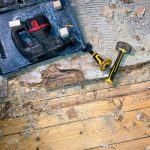Basements in the UK often face dampness, making them prime targets for mold growth. Understanding how to combat this issue is vital for maintaining a healthy home. This guide presents effective, practical strategies to keep mold at bay. By implementing simple measures and preventive techniques, you can create a drier, healthier environment in your basement. Say goodbye to musty odors and unsightly patches and enjoy peace of mind knowing your space is mold-free. Let’s explore the best methods for achieving mold prevention and safeguarding your home.
Understanding Mold Growth in Basements
Basements in the UK often face challenges with mold growth due to their unique environmental conditions. Various types of mold, such as Aspergillus, Cladosporium, and Penicillium, are commonly found in these areas. Each type thrives under different circumstances, but they all share a reliance on moisture, which is abundant in basements.
Dans le meme genre : Find your ideal insulated cup with straw for every sip
Basement moisture is a significant factor contributing to mold proliferation. Moisture can originate from multiple sources, including groundwater seepage, condensation, and leaks. These damp conditions provide an ideal breeding ground for mold, which requires not only moisture but also organic material to feed on, like wood, paper, and certain types of insulation.
The UK climate exacerbates these issues, as it is often humid and rainy, increasing the likelihood of moisture accumulation in basements. The frequent rainfall and cooler temperatures create an environment where moisture is slow to evaporate, thus maintaining a consistently damp setting. This persistent dampness in combination with poor ventilation can lead to significant mold growth, impacting both the structural integrity of buildings and the health of inhabitants.
A lire aussi : Choosing Energy-Efficient Windows for Your Victorian Home: A Comprehensive Guide for UK Homeowners
Preventing mold requires managing moisture levels effectively, ensuring proper ventilation, and addressing any leaks promptly. Understanding these dynamics is crucial for anyone dealing with basement mold issues in the UK.
Identifying Mold Risks in Your Basement
Understanding potential mold risks in your basement is essential for maintaining a healthy home environment. A thorough basement inspection can help identify early signs of mold and moisture, preventing more severe issues down the line.
Signs of moisture include damp walls, a musty odour, and visible water stains. These are often the first indicators of mold presence. Pay attention to any peeling paint or wallpaper, as these can also signal underlying moisture problems.
During your inspection, focus on key areas like corners, beneath windows, and near plumbing fixtures. These spots are particularly susceptible to moisture accumulation. Check for any cracks in the foundation, as these can allow water ingress, further exacerbating mold growth.
For an effective inspection, homeowners can use tools like moisture meters and hygrometers. A moisture meter helps detect hidden dampness within walls and floors, while a hygrometer measures humidity levels, ensuring they remain below the threshold conducive to mold growth.
By following this homeowner guide, you can take proactive steps to manage mold risks. Regular inspections and addressing issues promptly will help safeguard your basement against mold, ensuring a healthier living space.
Essential Preventative Measures
Taking preventative measures is crucial in combating basement mold. A primary step is ensuring proper ventilation. Basements often lack airflow, which can trap moisture and foster mold growth. Installing vents or using fans can help circulate air, reducing humidity levels and discouraging mold.
In addition to ventilation, employing dehumidifiers is an effective strategy for moisture control. These devices extract excess moisture from the air, maintaining a dry environment less conducive to mold. Place dehumidifiers in areas prone to dampness and monitor their efficiency regularly. Adjusting settings based on humidity levels ensures optimal performance.
Addressing structural issues is another key aspect of mold prevention. Sealing cracks and gaps in walls and floors can significantly reduce moisture intrusion. Water can seep through even the smallest openings, so thorough inspection and repair are essential. Use waterproof sealants to close these vulnerabilities, providing an additional barrier against moisture.
By implementing these preventative measures, you can effectively manage moisture levels in your basement. This proactive approach not only minimizes the risk of mold but also contributes to a healthier home environment. Regular maintenance and vigilance are vital in sustaining these efforts, ensuring your basement remains mold-free.
Maintenance Tips for Basements
Maintaining your basement effectively requires a combination of regular checks and strategic actions. Developing a consistent cleaning schedule is essential. Regular cleaning not only keeps the area tidy but also helps in early detection of potential mold issues. Dust and debris can trap moisture, so ensuring surfaces are clean reduces the risk of mold proliferation.
Monitoring humidity levels is another crucial aspect of basement maintenance. Humidity should ideally be kept below 60% to prevent mold growth. Use a hygrometer to track these levels consistently. If humidity rises, consider using a dehumidifier to maintain a dry environment. Regularly inspect the device for efficiency, ensuring it operates optimally.
Incorporating seasonal maintenance tasks can further aid in mold prevention. During wet seasons, check for any leaks or water ingress, especially after heavy rain. Ensure that gutters and downspouts are clear to direct water away from the foundation. In colder months, inspect insulation and heating systems to prevent condensation.
By adhering to these maintenance tips, you can create a healthier basement environment. Regular attention to cleaning, humidity, and seasonal tasks will significantly reduce the risk of mold, safeguarding both your home and health.
Recommended Products for Mold Prevention
When it comes to mold prevention products, selecting the right solutions can make a significant difference in maintaining a healthy basement. One of the most effective basement solutions includes the use of mold-resistant paints and sealants. These products create a protective barrier on surfaces, preventing moisture penetration and inhibiting mold growth. Look for paints specifically designed for high-moisture areas, as they offer enhanced resistance against dampness.
For effective humidity control, dehumidifiers are indispensable in UK basements. They work by extracting excess moisture from the air, keeping humidity levels in check. When choosing a dehumidifier, consider models with features like automatic humidity sensors and energy efficiency ratings. These ensure the device operates optimally without excessive energy consumption.
In addition to commercial products, DIY products and natural remedies can also aid in moisture reduction. For instance, placing bowls of baking soda or charcoal in damp areas can help absorb excess moisture naturally. Moreover, essential oils with antifungal properties, such as tea tree oil, can be used as a natural deterrent against mold.
By integrating these mold prevention products into your routine, you can effectively combat moisture issues and maintain a healthier, mold-free basement environment.
Addressing Common Basement Moisture Issues
Understanding and resolving moisture issues in basements is crucial for maintaining a healthy home environment. Identifying the sources of water entry is the first step in effective basement solutions. Common entry points include cracks in walls or floors, window wells, and poorly sealed doors. Conducting a thorough inspection can help pinpoint these vulnerabilities.
Once identified, addressing these sources involves targeted home repair strategies. Sealing cracks with waterproof sealants and ensuring window wells are properly covered are effective measures. Additionally, installing or maintaining a sump pump can significantly mitigate water accumulation. Sump pumps are essential in areas prone to flooding, as they actively remove water from the basement.
Proper installation and regular maintenance of sump pumps are vital for their longevity and efficiency. Ensure the pump is correctly positioned and test it periodically to confirm its functionality.
Managing drainage around the foundation is another critical aspect of preventing moisture issues. Ensure that gutters and downspouts direct water away from the foundation, reducing the risk of seepage. Grading the landscape to slope away from the house can also aid in effective drainage. Implementing these basement solutions can help maintain a dry and healthy living space.
Local Climate Considerations in the UK
Understanding the UK climate is essential when addressing basement moisture issues. The humidity levels in the UK vary significantly across regions, impacting the potential for mold growth. Coastal areas, for instance, often experience higher humidity due to the proximity to the sea, which can exacerbate moisture problems in basements. In contrast, inland regions may face different challenges, such as heavy rainfall contributing to groundwater seepage.
Regional mold risks are influenced by these weather patterns. In the north, cooler temperatures and frequent rain can lead to persistent dampness, while southern areas might deal with occasional flooding. These conditions necessitate tailored approaches to mold management.
Accessing local resources can provide climate-specific advice. Many UK councils offer guidance on managing humidity and preventing mold, catering to the unique challenges of each region. Additionally, engaging with local contractors familiar with regional weather patterns can be beneficial for effective mold prevention strategies.
Case studies of successful mold management in UK homes highlight the importance of addressing regional climate factors. For example, a home in the rainy Lake District might focus on robust drainage systems, while a property in the drier southeast could prioritize ventilation improvements.
Frequently Asked Questions about Mold in Basements
Understanding mold FAQs can help homeowners address common concerns effectively. One frequent question is: Can mold grow in any basement? Yes, mold can thrive in any basement if conditions are right. Moisture and organic material are key contributors. Ensuring proper ventilation and moisture control is crucial to prevent growth.
Another common inquiry is: Is all mold dangerous? Not all mold is harmful, but certain types can cause health issues. If you notice persistent health symptoms like allergies or respiratory problems, it may be wise to consult a professional for testing and remediation.
Homeowners often ask: What are the first steps in mold remediation? Begin by identifying and eliminating moisture sources. Use dehumidifiers and improve ventilation. Clean affected areas with mold-specific cleaners and remove severely damaged materials.
When should you consult a professional? If mold covers a large area or if you have health concerns, professional intervention is recommended. Experts can provide thorough assessments and ensure safe removal.
For homeowner questions about mold, understanding these basics can aid in effective management. Always prioritize safety and consider professional guidance when needed.
Visual Aids and Resources
Understanding basement mold prevention can be greatly enhanced with visual guides and resources. Diagrams illustrating proper ventilation setups are invaluable for visual learners. These diagrams can show homeowners how to effectively position vents and fans to ensure optimal airflow, which is crucial in reducing moisture levels.
Infographics on moisture control techniques provide a concise and clear overview of strategies to manage humidity. These visual aids can include step-by-step instructions for using dehumidifiers, sealing cracks, and employing mold-resistant paints. They serve as quick references for homeowners looking to implement or improve their mold prevention strategies.
For those seeking DIY help, accessing local UK resources is beneficial. Many councils and community groups offer support for homeowners dealing with basement mold. These resources often include workshops, online forums, and expert advice tailored to regional climate challenges. Engaging with these support groups can provide practical insights and shared experiences, empowering homeowners to tackle mold issues effectively.
Incorporating visual guides and tapping into local resources not only aids in understanding but also in executing effective mold prevention techniques. These tools are essential for creating a healthier and mold-free basement environment.
















